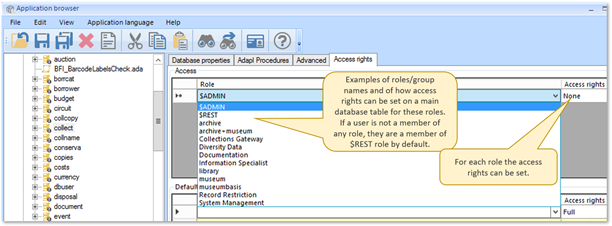Access rights and the permissions model
Application Administrators will find more about the following in the Axiell Designer Help:
- Details about users and roles.
- Details about user authentication and access rights.
The Axiell Collections permissions model is comprehensive and granular and access rights can be assigned to individual fields, records and data sources![]() The management of a collection can involve a vast amount of information about objects / items / books, people and organizations, events, administration and more. This information is stored as records in data sources. Each data source stores a specific type of information: details about collection items, people, events, loans, and so on., as well as to functions such as record creation, editing and deletion. The model is based on roles (also called user groups), and an unlimited number of roles can be configured in the application. For the most part, the access rights system is managed by the Application Administrator using Axiell Designer
The management of a collection can involve a vast amount of information about objects / items / books, people and organizations, events, administration and more. This information is stored as records in data sources. Each data source stores a specific type of information: details about collection items, people, events, loans, and so on., as well as to functions such as record creation, editing and deletion. The model is based on roles (also called user groups), and an unlimited number of roles can be configured in the application. For the most part, the access rights system is managed by the Application Administrator using Axiell Designer![]() A tool for designing, creating, customizing and managing Axiell Collections applications and databases, broadly speaking, the Axiell Collections Model Application. As well as managing databases, including user access and permissions, Designer is used for such tasks as translating field labels, tooltips, values in drop lists, etc.. Management of users and permissions is flexible and supported in various ways, including integration with Active Directory (Active Directory user groups can be applied as roles in the Axiell Collections access rights system).
A tool for designing, creating, customizing and managing Axiell Collections applications and databases, broadly speaking, the Axiell Collections Model Application. As well as managing databases, including user access and permissions, Designer is used for such tasks as translating field labels, tooltips, values in drop lists, etc.. Management of users and permissions is flexible and supported in various ways, including integration with Active Directory (Active Directory user groups can be applied as roles in the Axiell Collections access rights system).
Tip: You can select Account>Information in the Main menu to identify which roles have been assigned to you in Collections.

Roles can be linked to almost any part of Axiell Collections, both to database components (up to individual fields and records) and to functions such as record creation and editing, deletion of records, location management and reporting. Access rights can be applied at the individual record level to make records accessible or not to specific groups of users, including (external and internal) systems that use the Axiell Collections API.
Roles can be assigned the access rights None, Read-Only, Read-Write and Full. When configuring a role that has None access to a field, the field will become invisible to members of this role.
By applying access rights at the record level (on the Management details panel in Record details View), authorized users can decide which users get read and/or write access to these records. This can also be used as a simple way to publish records in selected applications such as web portals simply by granting users or roles access to records or specific parts of the database.


